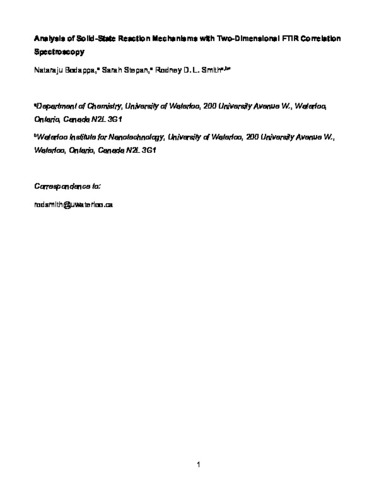| dc.contributor.author | Bodappa, Nataraju | |
| dc.contributor.author | Stepan, Sarah | |
| dc.contributor.author | Smith, Rodney | |
| dc.date.accessioned | 2023-05-01 18:04:34 (GMT) | |
| dc.date.available | 2023-05-01 18:04:34 (GMT) | |
| dc.date.issued | 2021-01-28 | |
| dc.identifier.uri | https://doi.org/10.1021/acs.inorgchem.0c03189 | |
| dc.identifier.uri | http://hdl.handle.net/10012/19377 | |
| dc.description | This document is the Accepted Manuscript version of a Published Work that appeared in final form in Inorganic Chemistry, copyright © American Chemical Society after peer review and technical editing by publisher. To access the final edited and published work see https://doi.org/10.1021/acs.inorgchem.0c03189 | en |
| dc.description.abstract | The utility of two-dimensional generalized correlation spectroscopy (2D-COS) for tracking complex solid-state reactions is demonstrated using infrared spectra acquired during a photochemically induced decomposition reaction. Eleven different thin films, consisting of six monometallic and five bimetallic 2-ethylhexanoate complexes, were tracked as a function of photolysis time. Overlapping peaks in the infrared fingerprint region are readily discriminated using 2D-COS, enabling individual vibrational components to be used to distinguish whether carboxylate ligands are free/ionic or bound in a chelating, bridging, or monodentate fashion. This classification enables the decomposition mechanism to be tracked for all 11 samples, revealing that ligands bound in monodentate and bridging fashions are first converted to chelates before being lost as volatile products for all samples. The magnitude of the measured first-order rate constants for loss of chelated ligands is found to correlate linearly to the asymmetric stretching frequency of monodentate ligands but exhibits a V shape when plotted against the electronegativity of the metal center. We propose that loss of chelated ligands proceeds via C–O scission for highly electronegative transition metals but M–O scission for transition metals with low electronegativity. These results establish 2D-COS as a powerful tool to deconvolute and correlate individual components, enabling mechanistic analysis of complex chemical reactions. | en |
| dc.description.sponsorship | NSERC, RGPIN-04184-2017 | en |
| dc.language.iso | en | en |
| dc.publisher | American Chemical Society | en |
| dc.relation.ispartofseries | Inorganic Chemistry; | |
| dc.subject | absorption | en |
| dc.subject | ligands | en |
| dc.subject | organic reactions | en |
| dc.subject | precursors | en |
| dc.subject | transition metals | en |
| dc.title | Analysis of Solid-State Reaction Mechanisms with Two-Dimensional Fourier Transform Infrared Correlation Spectroscopy | en |
| dc.type | Article | en |
| dcterms.bibliographicCitation | Bodappa, N., Stepan, S., & Smith, R. D. (2021). Analysis of solid-state reaction mechanisms with two-dimensional Fourier transform infrared correlation spectroscopy. Inorganic Chemistry, 60(4), 2304–2314. https://doi.org/10.1021/acs.inorgchem.0c03189 | en |
| uws.contributor.affiliation1 | Faculty of Science | en |
| uws.contributor.affiliation2 | Chemistry | en |
| uws.typeOfResource | Text | en |
| uws.peerReviewStatus | Reviewed | en |
| uws.scholarLevel | Faculty | en |

